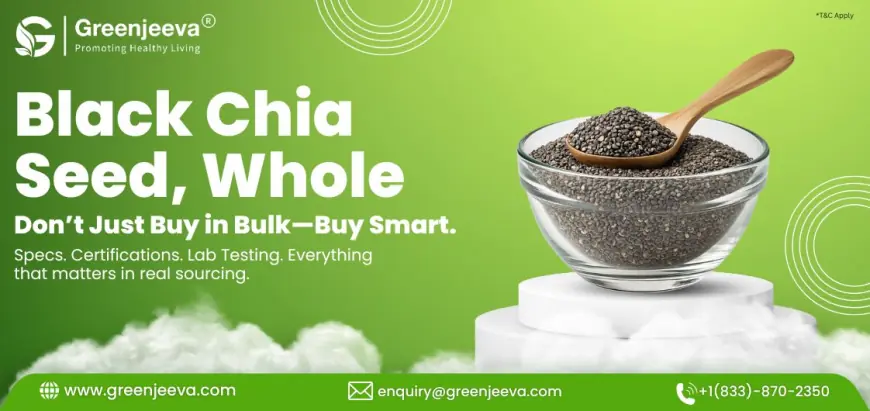Black Chia Seed for North America: Sourcing the Right Quality

Once considered a niche health food, black chia seeds have now found a permanent place in mainstream nutrition. From smoothies to cereal bars, dairy-free beverages to clean-label supplements, chia seed, whole is rapidly becoming a staple ingredient in North American food innovation. According to market research, chia seed imports to the U.S. and Canada have surged over the past five years, fueled by rising demand for plant-based protein, omega-3s, and dietary fiber.
But as this boom continues, a new question emerges for procurement teams and product developers:
Are you sourcing the right quality of chia seeds to meet both consumer expectations and regulatory compliance?
Chia Market Snapshot in North America
1. U.S. Chia Seed Imports (2018 vs. 2023) take timeline on or after 2025.
-
2018: ~9,800 metric tons
-
2023: ~17,500 metric tons (+78%)
2. Top Exporting Countries to North America
-
Paraguay
-
Mexico
-
Bolivia
-
Argentina
3. CAGR for Chia-Based Products (2023-2028)
-
Functional beverages: 8.9%
-
Nutraceuticals: 7.4%
-
Vegan snacks and bakery: 9.1%
Sources: USDA, Statista, Grand View Research
Why Chia? A Functional Superseed That Checks All the Boxes
In an increasingly label-conscious marketplace, whole black chia seeds offer a rare trifecta of value:
-
Nutrient Density: Omega-3s, fiber, calcium, magnesium, antioxidants
-
Clean-Label Ready: No processing or synthetics involved
-
Multi-Industry Use: Functional foods, nutraceuticals, bakery, beverages, and even pet care
This makes bulk chia seed buyers a critical link in the quality control chain.
Top Applications for Whole Black Chia Seeds

What "Right Quality" Really Means When Buying Bulk Chia Seeds
Not all chia is created equal. With rising demand comes rising risk—including contamination, adulteration, and mislabeling. Here's what sourcing managers need to watch for:
1. Seed Integrity: Whole vs. Milled or Damaged
Bulk chia seeds should be uniform, whole, and unprocessed. Broken or milled seeds degrade faster and may not meet shelf-life or formulation standards.
2. Moisture Content: Ideally < 10%
Higher moisture increases microbial risk and reduces shelf stability. Always request a Certificate of Analysis (CoA) confirming moisture levels.
3. Microbial Load and Heavy Metals
Ensure chia is tested for:
-
Total Plate Count (TPC)
-
E. coli, Salmonella, Yeast & Mold
-
Heavy metals (Lead, Arsenic, Cadmium, Mercury)
Choose suppliers with third-party lab testing and documentation.
4. Foreign Matter and Cleaning Protocols
-
Are the seeds machine cleaned? Gravity tables? Optical sorters?
-
What SOPs are in place to remove sticks, stones, or husks?
-
Check for mesh sieve reports to verify cleaning standards.
5. Certifications and Documentation
Look for:
-
USDA Organic / Canada Organic
-
Non-GMO Project Verified
-
Kosher, Halal, ISO, GMP
-
Full Batch Traceability and Allergen Statements
Buyer Checklist – Premium Black Chia Seed, Whole
Must-Have Specs:
-
Moisture: <10%
-
Mesh Size: Uniform, typically 18-20
-
Odor/Flavor: Neutral, earthy
-
Color: Dark black, no discoloration
-
Shelf Life: 18-24 months in proper storage
Testing Reports:
-
Microbial Load (TPC, E. coli, Salmonella)
-
Heavy Metals Panel
-
Pesticide Residue Analysis
-
Mycotoxins (if applicable)
Certifications:
-
USDA Organic
-
Non-GMO Project
-
Halal / Kosher
-
ISO/GMP
Documents to Request:
-
CoA (Certificate of Analysis)
-
MSDS (Material Safety Data Sheet)
-
Allergen Statement
-
Supplier HACCP Plan
Red Flags to Watch Out For in Bulk Chia Procurement
-
Price significantly lower than market average
-
No third-party lab documentation
-
Generic labels like "chia seed" without origin
-
No consistency across batches (color, smell, size)
If you’re seeing any of the above, it’s time to question your supplier.
How North American Buyers Can Stay Ahead
With increased scrutiny from regulators and consumers alike, the opportunity lies in premium, traceable, clean-label chia seed sourcing. Whether you're building a chia-based SKU or integrating it into a blend, the future belongs to those who know what’s inside their supply chain.
Final Tip:
Always sample and audit your chia seed suppliers, not just once—but with every batch. Your end products (and your brand's reputation) depend on it.
Conclusion: The Real Advantage Isn’t Just in Supply—It’s in Quality
As North America's appetite for chia continues to grow, one truth remains: sourcing the right quality black chia seed, whole, is no longer optional. It's a competitive edge.
So ask yourself: Is your current supply clean, certified, and lab-tested? Or is it just filling a bag?
For those who care about clean-label integrity, functionality, and traceability, choosing the right chia matters.
What's Your Reaction?
 Like
0
Like
0
 Dislike
0
Dislike
0
 Love
0
Love
0
 Funny
0
Funny
0
 Angry
0
Angry
0
 Sad
0
Sad
0
 Wow
0
Wow
0


















































